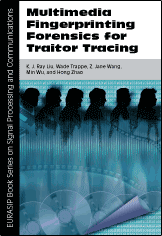News Story
Engineers Pioneer New Digital Forensics Technology

Multimedia Fingerprinting Forensics for Traitor Tracing documents the digital fingerprinting technology research conducted by Wu and Liu.
“This is must-use technology. The concepts we have pioneered will be used to protect the digital resources of the future.”
Dr. Ray Liu, professor in ECE & the Institute of Systems Research
As industry and government rely increasingly on digitized content, the problem of protecting electronic assets is growing more and more challenging. Recent headlines have documented a new generation of cyber criminals who work together to engage in multimedia piracy, unauthorized data dissemination and security leaks.
The Clark School’s Min Wu, assistant professor of electrical and computer engineering (ECE) and the Institute for Advanced Computer Studies, and K.J. Ray Liu, professor in ECE and the Institute for Systems Research, are developing innovative new “cyber forensics” technologies that will not only protect digital resources but also trace those who attempt to steal or misuse them through sophisticated “collusion attacks,” a common piracy method used by today’s cyber thieves. Collusion attacks occur when multiple users conspire to electronically steal and distribute copyrighted or classified material, diluting or erasing the original digital ID, or fingerprint, from the stolen multimedia content to avoid implication.
Wu and Liu’s new, interdisciplinary digital fingerprinting technology involves anti-collusion codes (ACC). ACC protects multimedia content without compromising the quality of the multimedia product or inhibiting legitimate uses.
This powerful new technology, documented in the researchers’ 2006 book, Multimedia Fingerprinting Forensics for Traitor Tracing, could help interests as varied as those of Hollywood and the U.S. Department of Homeland Security. Film and recording industries, for example, want to better protect the commercial copyrights of their products, which are distributed both domestically and abroad over the Internet and via satellites. They are actively seeking technologies that will individually and invisibly protect products without resorting to controversial methods that add programs to individuals’ computers or alter them in other ways.
The Maryland engineers’ digital fingerprinting method avoids this unpopular result. Wu and Liu’s work, which began in 2001, protects multimedia content from unauthorized redistribution by embedding a unique ID that leaves a distinct fingerprint on each user’s copy. This ID can accurately identify which users have contributed to a piracy attack. They have developed not only the computer code but also the tools needed to embed, detect and decode the technology.
Their new ACC fingerprinting performs much better than existing methods. Fingerprints can be extracted to help identify culprits when unauthorized duplication is attempted. The technology can be applied to images, video, audio, and special documents like maps. It can even be used to protect live multicasts, such as pay-per-view events. The system can accommodate up to millions of users, an especially important feature for satellite and Internet multimedia distribution.
“We have introduced concepts that no one has thought of before,” Wu says.
The pair believe the presence of sophisticated embedded ACC technology in digital resources, with its ability to unmask colluders, will be such a powerful deterrent that it actually will prevent these kinds of piracy attempts. “The message our technology sends is, ‘Don’t bother to try anything, because we can catch you,’” according to Liu.
In addition to its usefulness for commercial purposes, ACC technology also could have major national security implications. The tragic events of 9/11 emphasized the importance of information sharing, not only among U.S. federal agencies, but also among their international counterparts. Yet without effective “traitor tracing” tools to protect the sensitive nature of multimedia data shared among a group of users, entities have been understandably reluctant to participate in sharing operations. In the truly secure intelligence sharing that ACC technology could provide, multimedia information could be tracked, and those involved in attempts at unauthorized redistribution could be identified.
The Clark School team’s award-winning research has captured the attention of colleagues in academia and industry worldwide. In addition, MIT’s Technology Review magazine recently named Min Wu as one of 100 individuals under age 35 whose innovative work has made a profound impact on the world.
Liu is confident in ACC’s potential: “This is must-use technology,” he says. “The concepts we have pioneered will be used to protect the digital resources of the future.”
Published March 28, 2006









